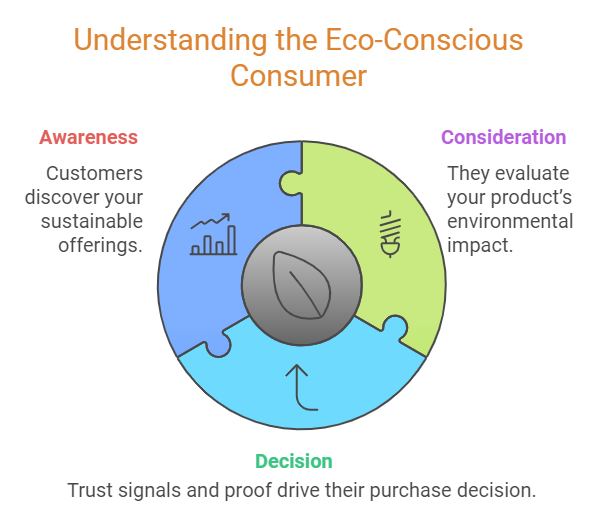Introduction
This blog post explores actionable strategies for balancing CRO with sustainable business practices, ensuring you remain competitive while contributing to a greener future.
Understanding Your Eco-Conscious Audience
Today’s consumers are more informed and environmentally conscious than ever. According to a Nielsen report, 73% of global consumers are willing to change their consumption habits to reduce environmental impact. This shift in consumer behaviour directly impacts how you approach CRO for sustainable products.
The Eco-Friendly Buyer’s Journey
To optimise conversions, it’s crucial to understand the buyer’s journey for eco-conscious customers:
- Awareness: Customers discover your sustainable offerings.
- Consideration: They evaluate your product’s environmental impact.
- Decision: Trust signals and proof drive their purchase decision.
SEO Tactics for Green Products
Search Engine Optimisation (SEO) is a powerful tool for attracting eco-conscious customers. By targeting the right keywords and aligning content with user intent, you can increase visibility and drive conversions.
Long-Tail Keywords and On-Page Content
Use specific, long-tail keywords like “upcycled vegan leather boots” to attract niche audiences. Optimise your product pages to highlight the sustainable benefits of your offerings. For example, emphasise certifications (e.g., Fair Trade or Carbon Neutral) and eco-friendly materials.
Matching Content with Buyer Intent
Ensure your content aligns with the different stages of the buyer’s journey. Blog posts, product guides, and case studies can educate customers during the awareness and consideration phases, while clear CTAs and trust signals help convert them during the decision phase.
On-Page Optimisation for Sustainability
Your website’s design and content play a critical role in balancing CRO with sustainability. Here’s how:
- Engaging Product Descriptions: Highlight eco-friendly benefits and unique selling points.
- Trust Signals: Display certifications, lab results, and partnerships with environmental organisations.
- Visual Proof: Use high-quality images and videos to showcase your sustainable practices.
User Experience (UX) and Technical SEO
A seamless user experience is fundamental to CRO. A slow, clunky website can deter even the most eco-conscious customers.
Page Speed and Mobile Optimisation
According to Google, a one-second delay in page load time can reduce conversions by up to 20%. Optimise your website for speed and ensure mobile responsiveness to cater to a broader audience.
Building Trust and Transparency
Trust is the cornerstone of sustainable CRO. Customers are more likely to buy from brands that are transparent about their environmental impact.
Sustainability Reports and Open Communication
Regularly publish sustainability reports and share your achievements with your audience. Address challenges openly to build credibility and trust.
“Transparency is the new marketing. Customers want to know the story behind the product, especially when it comes to sustainability.” — Jane Doe, Sustainability Expert
Leveraging Social Proof and Community
Social proof can be a powerful driver of conversions. Customer reviews, testimonials, and user-generated content can validate your sustainability claims.
Building a Community
Engage with your audience on social media by sharing educational content and sustainability tips. Create a sense of community around your brand’s eco-friendly mission.
A/B Testing and Data-Driven Decisions
A/B testing allows you to refine your CRO strategies while staying aligned with sustainable practices. Test different elements such as CTAs, landing pages, and product descriptions to determine what resonates most with your audience.
Analysing User Feedback
Use tools like Google Analytics and heatmaps to analyse user behaviour. This data can guide your optimisation efforts and ensure they align with your eco-friendly goals.
Case Studies and Examples
Real-world examples can provide valuable insights. For instance, Asphalte, a sustainable fashion brand, uses hero images and onsite notifications to promote new eco-friendly collections, driving both awareness and conversions.
Conclusion
Balancing CRO with eco-friendly practices is not just a trend—it’s a necessity for long-term success. By understanding your audience, leveraging SEO, optimising user experience, and building trust, you can drive conversions while staying true to your sustainability goals.
Ready to take the next step? Start implementing these strategies today and watch your business thrive sustainably. For more tips, check out our Sustainable Marketing Strategies and Eco-Friendly Web Design guides.

